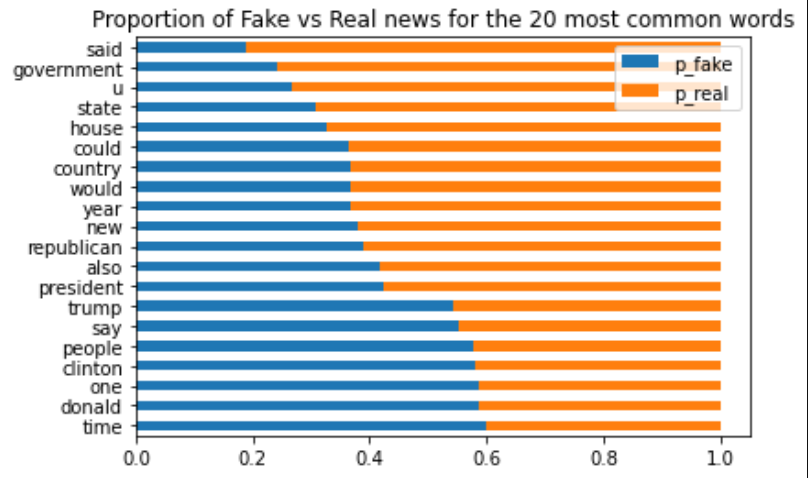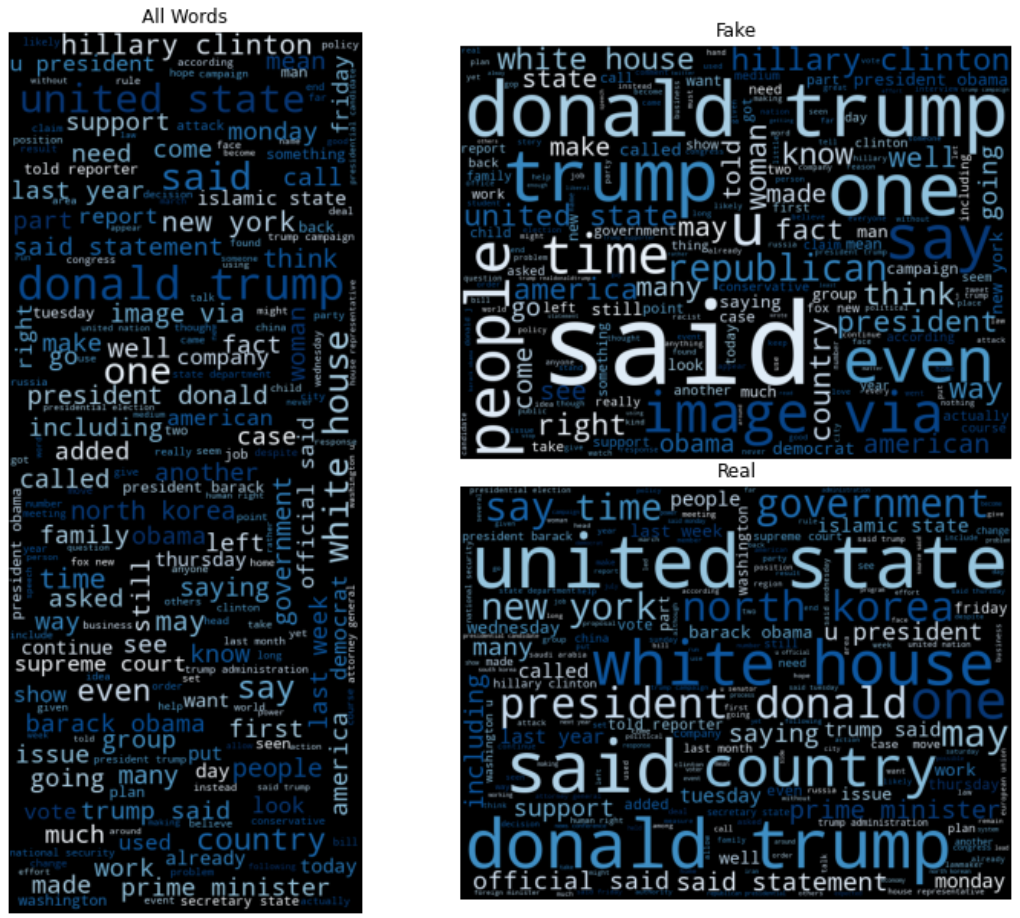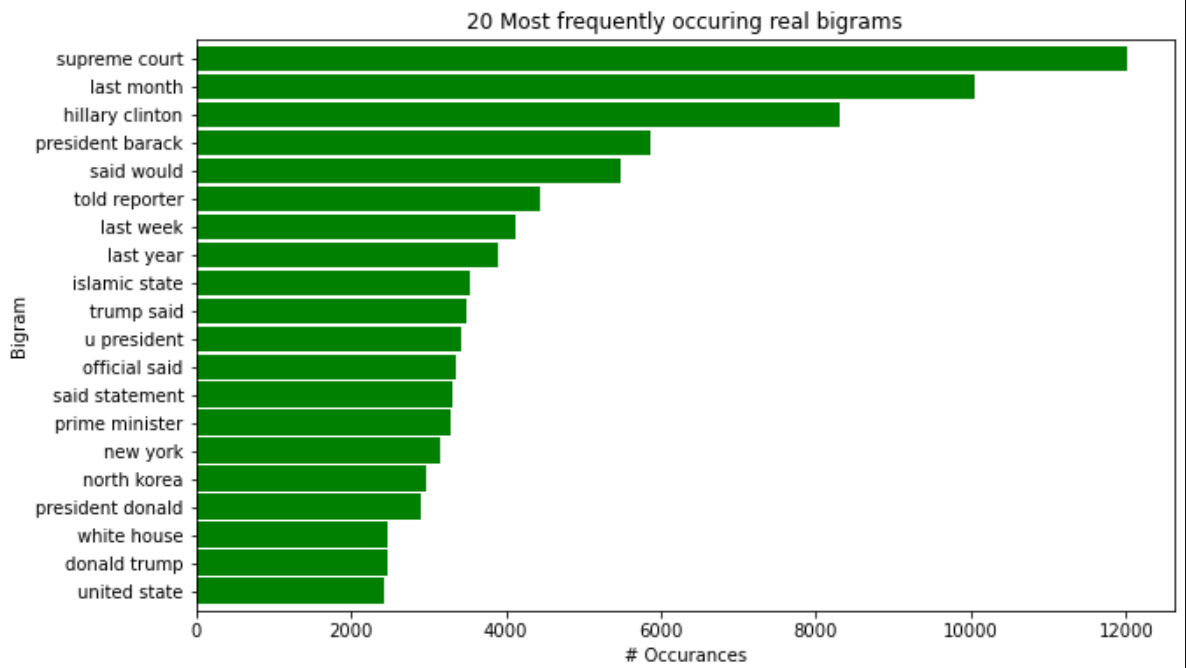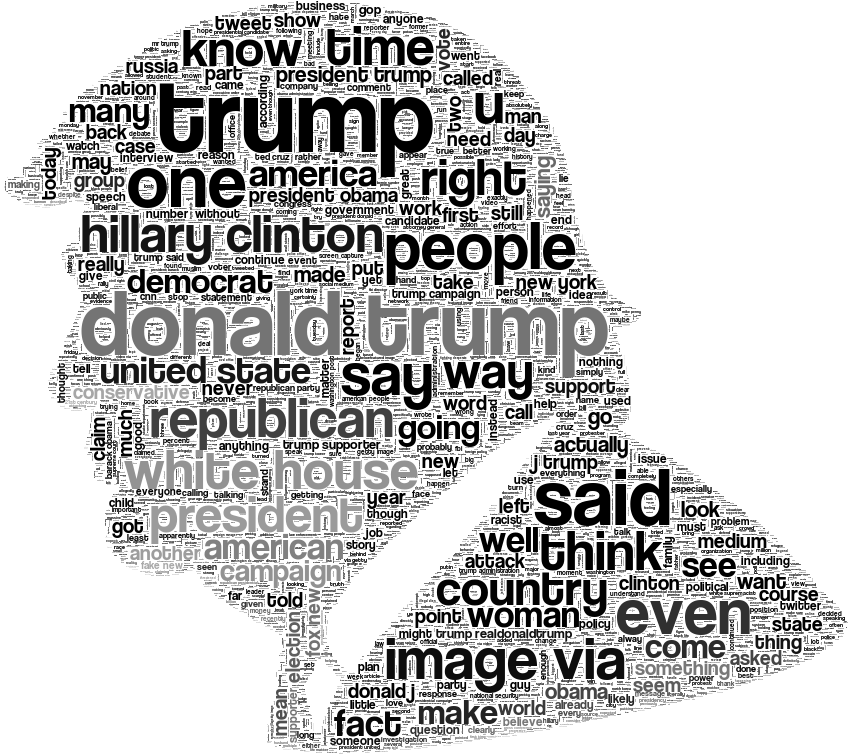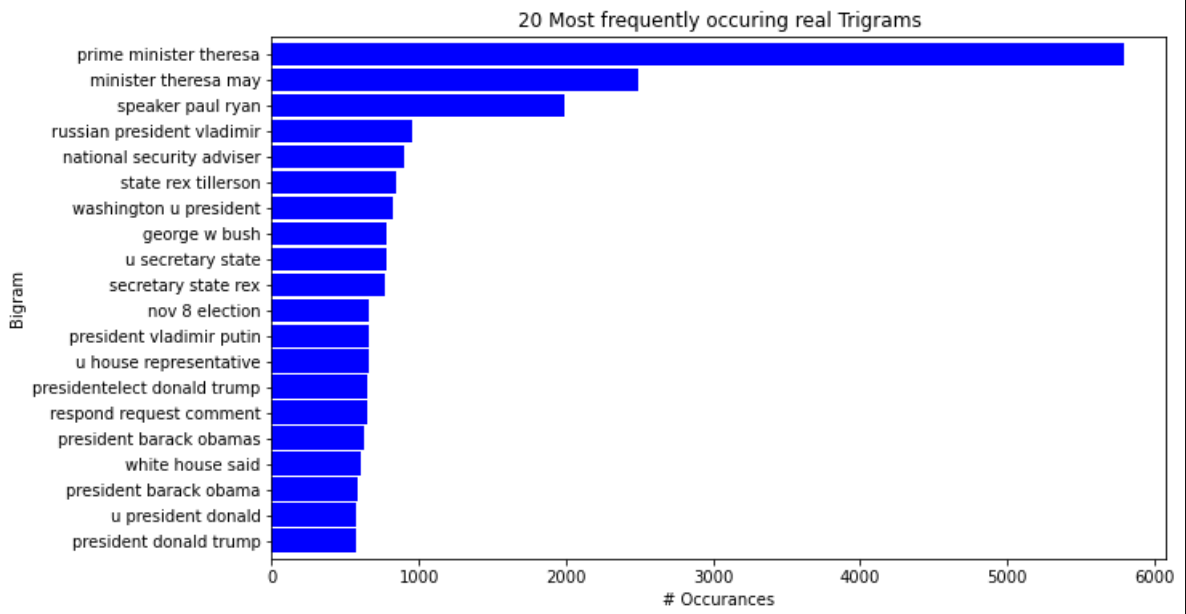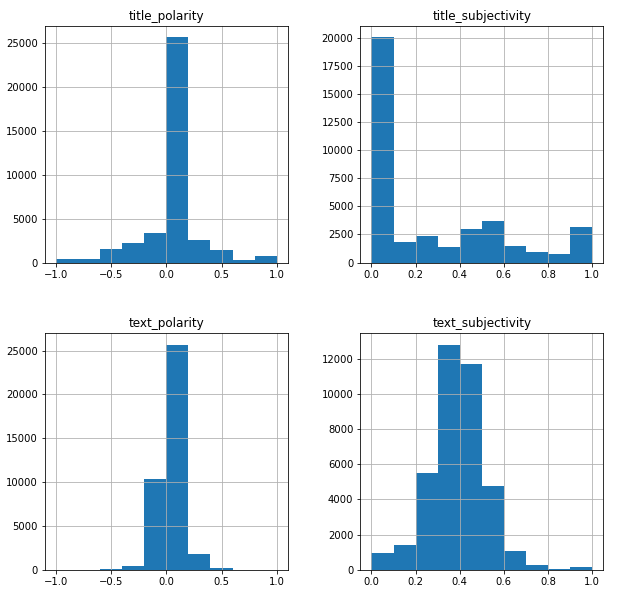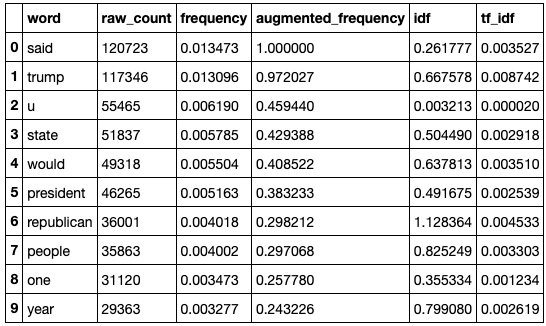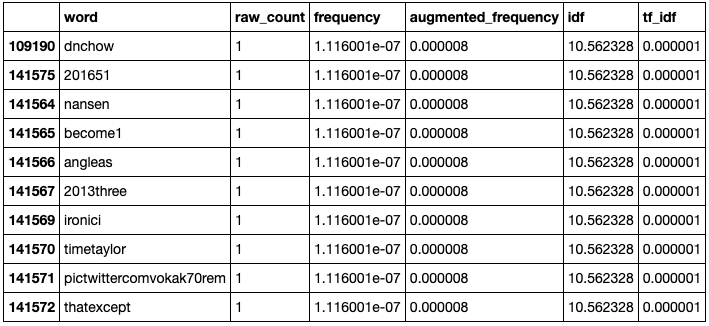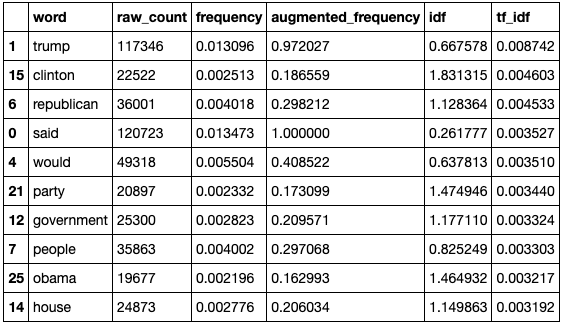What is our goal?
-
Our team seeks to differentiate fake news from real news through the exploration and analysis of keywords and phrases of random news articles. We will utilize NLP tools and build a classification model in hopes to shed light on purposely misleading information.
-
Fake News Detector Web App: http://easleyfakenewsdetector.com/
[Project Description] [Project Setup] [Project Planning] [Key Findings] [Data Dictionary] [Acquire & Prep] [Data Exploration] [Statistical Analysis] [Modeling] [Conclusion]
Click to expand!
- Within this project we will be using the fake news dataset acquired from the Kaggle database.
- We will clean the data through tokenizing, lemmatizing, vectorizing, and removing stop words.
- Then we will explore the data through bigrams and trigrams, while also generating word clouds.
- Lastly we will make a model that can accurately identify fake news articles.
- Create a classification model that can accurately identify fake news and real news articles while utilizing NLP tools like NLTK, Sentiment Analysis, and TF-IDF Vectorizer in addition to the standard data science tools.
- Our secondary goal is to create a public web application that can be used to identify fake news.
- After acquiring our MVP, we would like to create a deep learning model.
- We acquired the data from the Kaggle online database.
- 20,826 unqiue Real articles
- 17,903 unique Fake articles
- 38,729 total unique articles
- date of when the article was posted.
- subject of article
- title of article
- text of article
- clean_title
- clean_text
- is_fake
- title_polarity
- title_subjectivity
- text_polarity
- text_subjectivity
https://www.kaggle.com/clmentbisaillon/fake-and-real-news-dataset?select=Fake.csv
Click to expand!
- utilities.py - Follow the instructions to use the latest features
- python
- pandas
- nltk
- re
- numpy
- matplotlib.pyplot
- seaborn
- wordcloud
- PIL
- Scipy
- Sklearn
- Clone this repository
- Install utilities.py according to the instructions
Setup env.py
- Follow the instructions in the notebook for acquiring the data from GitHub if it's the first time running the notebook
Click to expand!
-
Acquisition of data through Kaggles online database.
-
Prepare and clean data with python/NLP tools - Jupyter Labs
- Tokenize
- Lemmatize
- Remove stop words
- Vectorize
-
Explore data
- Identify top 10 words in fake news and real news articales.
- Compare the proportion of words that show up in fake news vs real news.
- Generate bigrams and trigrams to visualize two to three word sequences and their relationships to fake or real news.
- Generate single word, bigram, trigram, word clouds to vizualize reiterations for specific words and word sequences.
- Calculate TF, IDF, TF-IDF.
- Create a final explore.py with helper fucntions
-
Feature Engineering (after MVP)
- Use sentiment anaylis to add extra features to second iteration model.
- Add more features based on findings in exploration.
-
Modeling
- Establish baseline
- Evaluate training data on each calssifcation model type
- Select MVP model
- Create final model.py with helper functions
-
Presentation
- Finalize README
- Create story board
- Write script
- Create MVP presentation
- Practice presentation
- Record
- Fake news articles are more prone to be polarized and subjective.
- Text polarity for fake news is less negative than the real news news articles.
- Text subjectivity of fake news articles is less subjective than real news articles.
- is_fake (If the news article is fake news)
Click to expand!
- Findings:
- The top words for fake news articles are: trump, said, people, president, one.
- The top words for real news articles are: said, trump, us, state, would.
- The top words for all news articles are: said, trump, us, state, would
- 50 percent of all articles had trump as a keyword, 54 percent of these instances are fake.
- Real news articles use words that are more centered around world events and places.
- Real news articles tend to have the most '... said' bigrams. We identifed this specifc bigram as a quote or statment from and individual.
- Fake news articles tend to have words with negative connotations such as bigoted, disgusting, pathetic, insane, and idiot.
- The higest amkount of instances is associated with the word said at 118359 instances.
- The word said only occured in 19% of fake articles, while 81% where associated with real news articles.
- The second highest ammount of intances is associated with the word/name trump at 115797 intances and making up over 53% being in fake news realted articles.
- Large amount of twitter usernames present in the text body of fake news. Over 24k twitter usernames total were found in fake news articles as opposed to 800 in real articles over the entirety of our dataset.
- Findings:
- We found that the mean text polarity of fake and real news was not significant enought to reject our null hypothesis.
- We found that the mean text subjectivity of fake news greater than the subjectivity of real news.
- We discovered that there was little to no significant variance in text polarization, but when it came to the subjectivity, fake news articles were 22% more subjective in nature than real articles.
- Findings:
- The most reliable model was the logistic regression model with an in sample accuracy of .99 and an out of sample accuarcy of .98.
Click to expand!
| Attribute | Definition | Data Type |
|---|---|---|
| title | The title of the article | string |
| text | The text of the article | string |
| subject | The subject of the article | string |
| date | The date at which the article was posted | string |
| target | ------------------------------------ | --------- |
| is_fake | If the news article is fake news | boolean |
| ----- | ------------------------------------- | -------- |
| clean_title | Cleaned text of articles | string |
| clean_text | Cleaned title of articles | string |
| title_polarity | 1 to -1 the more negative, the more polarization in the article | float |
| title_subjectivity | 0 to 1 the closer to one the more subjective the title is | float |
| text_polarity | 1 to -1 the more negative, the more polarization in the article | float |
| text_subjectivity | 0 to 1 the closer to one the more subjective the article is | float |
Click to expand!
- Gather fake news dataset from Kaggle online database.
- To clean the data we had to:
- Lemmatized
- Tokenize
- Vectorized
- Remove stop words
- Remove duplicate rows
- Remove nulls and NANs
| Function Name | Purpose |
|---|---|
| _nlp_clean_titles_and_text | This function takes in a dataframe and applies, tokenize, lemmatize, basic_clean, and removes all stop words for each csv file. |
| nlp_basic_clean | Lowercases, removes non-ASCII characters, and removes non-alphanumeric (except ' or \s') from the passed in string. |
| nlp_tokenize | Applies the ToktokTokenizer.tokenize() method to the passed in string. |
| nlp_remove_stopwords | Generates a list of stop words then adds and/or removes the specified words from that stop word list. Any words from the original string that are not present in the stop word list are added to the filtered word list. Returns the joined filtered word list as a single string. |
| nlp_lemmatize | Applies the ToktokTokenizer.tokenize() method to the passed in string. |
- From here we :
- Combined the two csv files (fake.csv, real.csv)
- Set the date to data time format
| Function Name | | ----- | ----- | | _combine_csv_files | | _determine_value_in_correct_format | | _standardize_dates | | _drop_empty_rows | | wrangle_articles |
Click to expand!
- We found that the the most common fake news words were time, one, donald, people, clinton
- Said and donald trump are the tope two words in the fake news related articles.
- Said and donald trump are the top two words in the fake news related articles.
- This could be related to some quates that were infered by the press. (id like to look into this deeper and actualy compare if these statments match what trump acutaly said)
Findings 3: (Fake Bigrams)
- The bigrams for fake news articles are filled with "in house" events and places such as supreme count, republican party, and trumps twitter tag. (Hyper focused on the Republican Party and Trump)
Findings 4: (Real Bigrams)
- The bigrams for real news are filled with phrases that represent world events, significant moments in time and statments from others.
Findings 5: (Trump Fake News Cloud)
- This visual represents the word frequency in the articles contraining the word trump (52% of all articles), and that are considered fake news.
Findings 6: (Fake Trigrams)
-
Findings 7: (Real Trigrams)
-
Findings 8: (Polarity and Subjectivity)
- titles overall don't seem to be polarized or subjective
- text polarity and subjectivity look normally
distributed. Can perform T-tests
- fake articles are 46% of the dataset
- fake_news 22% higher mean subjectivity score
Findings 9: (Term Ferquency)
-
Findings 10: (Inverse Document Frequency)
-
Findings 11: (TF-IDF)
-
- General trend: As text subjectivity goes up text becomes more polarized in both directions
CLUSTER_0 - Is mostly real news articles with close to zero text_polarity and low text_subjectivity on average. This cluster can be named "unbiased_factual".
CLUSTER_1 - Articles are mostly fake with close to zero text_polarity and high text_subjectivity on average. This cluster contains "unbiased_mostly_non_factual" articles.
CLUSTER_2 - Articles are mostly fake articles with a positive mean and median text_polarity with high text_subjectivity on average. These are "positive_bias_non_factual" articles.
CLUSTER_3 - Articles have a negative mean and median text_polarity with moderate text_subjectivity on average. These articles are considered "negative_bias_mostly_factual".
CLUSTER_4 - Articles have high negative mean and median values for text_polarity and high text_subjectivity on average. These are "negative_bias_non_factual" articles.
CLUSTER_5 - Articles have positive mean and median text_polarity values and a moderate text_subjectivity score on average. These are "positive_bias_mostly_factual" articles.
| Function Name | Definition |
|---|---|
| _show_counts_and_ratios | This fucntion takes in a dataframe and column name. Will produce a valuecounts for each label and the percetage of the data it represents |
| _percentFakevsReal | This function takes in word_counts and returns a horizontal bar plot of the proportions of Fake vs Real news for the 20 most common words |
| _wordcounts_all | This function takes in word_counts. Makes sure all words for 'fake' and 'all' are greater than 10. Generates a ratio column of fake words to all words and returns a dataframe of all the word counts and ratios for all, fake, and real words |
| _wordcount_fake | This function takes in word_counts. Makes sure all words for 'fake' and 'real' are greater than 10. Generates a ratio column of fake words to real words and returns a dataframe of all the word counts and ratios for all, fake, and real words |
| _wordcount_real | This function takes in word_counts. Makes sure all words for 'fake' and 'real' are greater than 10. Generates a ratio column of real words to fake words and returns a dataframe of all the word counts and ratios for all, fake, and real words |
| _word_clouds_rfa | This function takes in all_words, fake_words, real_words. generates a word cloud for each aurgument with a fig size of (10, 8) and titles of all_cloud, fake_cloud, real_cloud. Returns a set of word clouds for all_words, fake_words, real_words |
| _fake_bigrams | This function takes in fake_words. Generates a horizonalt bar chart with x and y labels for the top 20 fake bigrams. |
| _real_bigrams | This function takes in real_words. Generates a horizontal bar chart with x and y labels for the top 20 real bigrams. |
| _fake_trigrams | This function takes in fake_words. Generates a horizontal bar chart with x and y labels for the top 20 fake trigrams. |
| _real_trigrams | This function takes in real_words. Generates a horizontal bar chart with x and y labels for the top 20 real trigrams. |
| fitclusters | Takes in the train, validate, test samples and the X_train, X_validate, X_test subsets, the number of clusters, the name of the group of clusters, name for the variable to plot on the x-axis, the name for the variable to plot on the y-axis, and the name of the variable used for the hue on the graph. The function uses these parameters to generate a plot of the train data by cluster and a plot of the train data color-coded by the compare_hue variable. |
Click to expand!
Stat Test 1:
- confidence_level = .95
- a = 1 - confidence_level
T-Test Hypothesis:
- HO: "The mean text polarity of fake news is the not more negative than real news"
- HA: "The mean text polarity of fake news is more negative than real news"
Results:
- t-stat: 3.3195
- p-value: 0.0009
- Result: We fail to reject the null hypothesis: The mean text polarity of fake news is the not more negative than real news
Stat Test 2:
- confidence_level = .95
- a = 1 - confidence_level
T-Test Hypothesis:
- HO: "The mean text subjectivity of fake news is the not more subjective than real news"
- HA: "The mean text subjectivity of fake news is more subjective than real news"
Results:
- t-stat: 74.0828
- p-value: 0.00
- Result: We reject the null hypothesis. We move forward with the alternative hypothesis: The mean text subjectivity of fake news is more subjective than real news
Click to expand!
Summary of modeling choices...
- Will run the following models:
- Logistic Regression
- Decision Tree
- Random Forest
- K Nearest Neighbors
Mode = is_fake = False Accuracy: .5484
-
Training/In-Sample:
- Accuracy: .99
- Recall False: .99
- Recall True: .98
-
Validation/Out-of-Sample
- Accuracy: .98
- Recall False: .99
- Recall True: .97
-
Training/In-Sample:
- Accuracy: .91
- Recall False: .94
- Recall True: .88
-
Validation/Out-of-Sample:
- Accuracy: .90
- Recall False: .93
- Recall True: .86
-
Training/In-Sample:
- Accuracy: .96
- Recall False: .98
- Recall True: .93
-
Validation/Out-of-Sample:
- Accuracy: .95
- Recall False: .97
- Recall True: .92
-
Training/In-Sample:
- Accuracy: .89
- Recall False: .97
- Recall True: .78
-
Validation/Out-of-Sample:
- Accuracy: .84
- Recall False: .96
- Recall True: .70
-
Training/In-Sample:
- Accuracy: .99
- Recall False: 1.00
- Recall True: .99
-
Validation/Out-of-Sample:
- Accuracy: .96
- Recall False: .97
- Recall True: .96
| Function Name | Definition |
|---|---|
| Model | Training/In Sample Accuracy | Validation/Out of Sample Accuracy | In Sample Recall False | In Sample Recall True | Out of Sample Recall False | Out of Sample Recall True |
|---|---|---|---|---|---|---|
| Logistic Regression | .99 | .98 | .99 | .98 | .99 | .97 |
| Decision Tree | .91 | .90 | .94 | .88 | .93 | .86 |
| Random Forest | .96 | .95 | .98 | .93 | .97 | .92 |
| K Nearest Neighbors | .89 | .84 | .97 | .78 | .96 | .70 |
| Naive Bayes | .99 | .96 | 1.0 | .99 | .97 | .96 |
-
Logistic Regression
-
Why did you choose this model?
- This model had the overall highst accuracy of .99 in sample and .98 out of sample.
- This mode l also had the least amount of overfitting with only a 1% decrease from in sample to out of sample tests.
- This model also had one of the best recal scores (number of fake news articles predicted / the actual number of fake news articles)
- Model Test Results
- Accuracy: .98
- Recall False: .99
- Recall True: .97
Click to expand!
Throughout this project our team was able to identify the top key words and phrases associated with fake and real news through the use of bigrams, trigams, and word frequency charts.
Through statistical testing, We discovered that there was little to no significant variance in text polarization, but when it came to the subjectivity, fake news articles were 22% more subjective in nature than real articles.
Our team is confident that we have a highly accurate model backed by statistical tests and proven real world implementation. At 98% accuracy we believe that our model can help bring balance to the internet while achieving our ultimate goal of reducing the occurrences of individuals falling victim to fake news.
- we recommend using our application in conjunction with other research knowing that there could be a possibility of bias depending on the data assigned to the model.
- We also recommend cloning our repo and diving deeper with deep learning models and neural networks.
- In the future our team would like to look at using the cluster names as new labels to increases our accuracy among new data and features.
- We would also like to conduct time series analysis on the polarity and subjectivity scores using the dates and time provided in the dataset.

